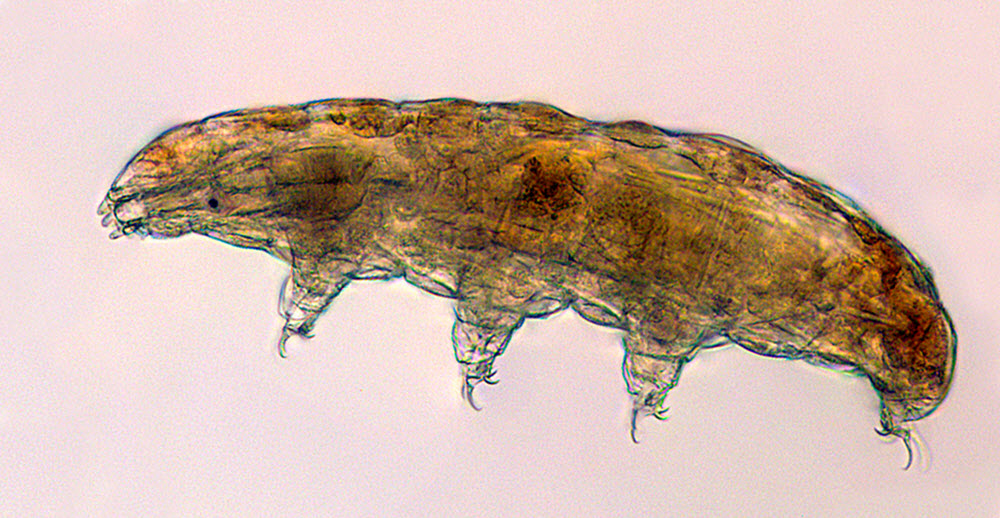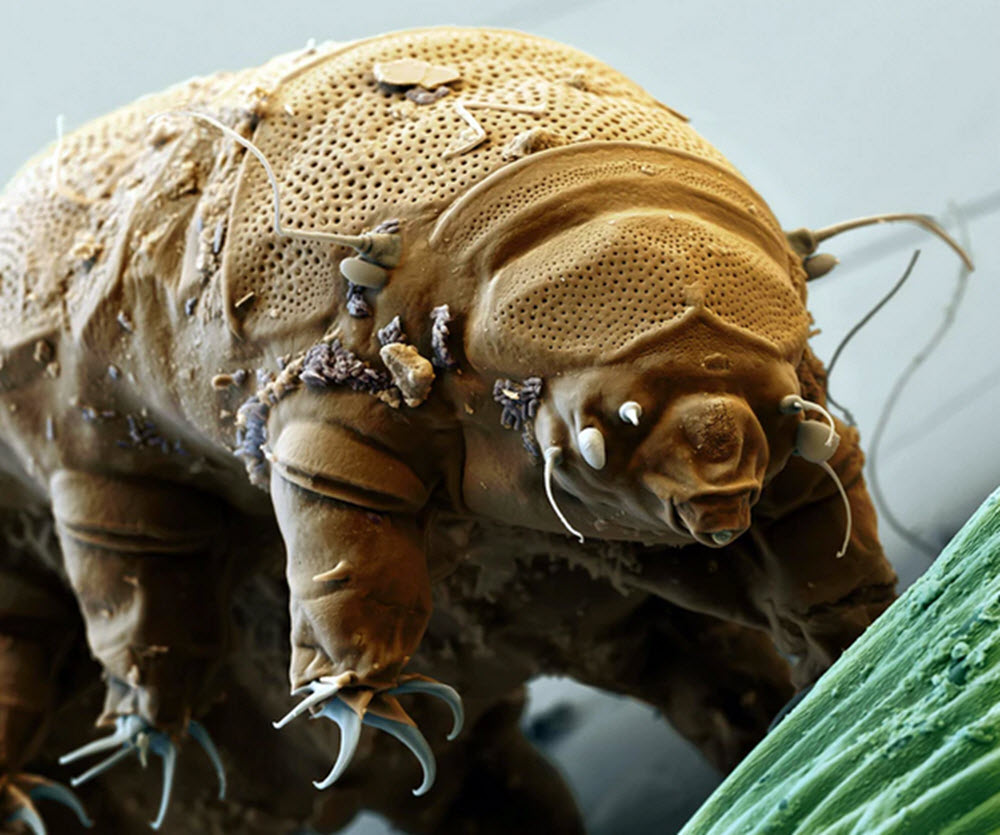Waterbears

The tardigrades – also known as waterbears and moss piglets – are a phylum of aquatic microanimals belonging to the classes Eutardigrada, Heterotardigrada and Mesotardigrada. Roughly 1,150 species have been scientifically described.
Tardigrades are extremely resilient and adaptable, and they are one of very few groups that have survived through all of Earth’s five mass extinctions. The phylum Tardigrada includes fossils dated to 530 million years ago (Cambrian period). In our time, tardigrades brought on space missions have proven their capacity for surviving outside the Earth’s protective athmosphere; at least short-term.
Here on our own planet, tardigrades are found in a wide range of enviroments, and they fill an important nische by being pioneer species that quickly inhabit new developing habitats.
Researchers have found tardigrades living in very taxing enviroments, such as:
- At 6,000 meter above sea level in the Himalayas
- In hot springs
- In sand dunes and on beaches
- 4,000 meters below the sea surface
- At both polar regions
- Under layers of solid ice
- In ocean sediments
- In stone walls
They are found in a lot of less extreme habitats as well, such as the ocean, lakes, ponds, meadows, leaf litter, soil, moss beds, and among lichens. They are most common in wet or moist enviroments.
Contents
Scientific classification
| Kingdom: | Animalia |
| Phylum: | Tardigrada |
| Classes: |
|
Surviving in extreme conditions
Waterbears are remarkably resilient and adaptable and have been discovered living in a wide range of environments, from the deep sea to mountaintops. They can handle the heat of mud volcanoes and the cold of Antarctica, and are also capable of surviving exposure to extreme pressures, air deprivation, radiation, dehydration, and starvation.
Because of their resilience, they have been brought on space missions and they have proven their ability to survive even exposure to outer space.
Temperature extremes
- Tardigrades have been shown to survive for several minutes at 151 °C (304 °F) and at −272 °C (−458 °F; 1 K).
- They can survive for several days at −200 °C (−328 °F; 73 K) and for at least three decades at −20 °C (−4 °F.
When tardigrades are exposed to very low temperatures, they reduce their water content from circa 85% water to just 3%. Without this severe dehydration, it would be more difficult for them to survive, since ice take up more space than water, and water inside the body that goes from fluid to frozen could case the tardigrade to “explode”.
Pressure extremes
- Tardigrades can withstand the extremely low pressure of a vaccum enviroment.
- Tardigrades can withstand high pressures exceeding 1,200 times the atmospheric pressure. Some specific species have been shown to withstand pressure of 6,000 athmosphere – which is almost 6 times the pressure of water in the Mariana Trench.
Radiation
Compared to other animals, including humans, tardigrades can survive extreme doses of raditation. Around 5-10 Gy (of gamma rays or heavy ions) could be fatal to a human, but for hydrated tardigrades the median lethal doses are 5,000 Gy for gamma rays and 6,200 Gy of heavy ions.
Tardigrades are highly capable when it comes to quickly repairing damage to their DNA caused by raditation.

Surviving extreme conditions in a dehydrated state
They survive in conditions that are horrible even by tardigrade standards, these amazing animals can enter a kind of super-dormant state. When they are provided with better conditions and water again, they hydrate and start foraging for food. They can even reproduce after such a long period of dormancy.
Tardigrades can suspend their metabolism down to less than 0.01% of normal metabolism and survive in a hydrated state for several years – and in exceptional cases for many years. Some tardigrades have woken up again after being severely dehydrated and without food and water for over 30 years.
Exactly how the tardigrade enters this dormant state varies: it can be via cryobiosis, osmobiosis, anhydrobiosis, or anoxybiosis. While dormant, the animal’s water content can drop to 1% of normal. Recent research indicate that the tardigrades make use of a unique type of disordered protein that replaces water in the cells.
Notably, a 120-year-old tardigraded found in dry moss did show some leg movement after being hydrated. However, this doesn’t really count as “surviving”.
Tardigrades in space
Tardigrades are the first known animal to survive without any protection outside in space.
The FOTOM-M3 mission of 2007
Tardigrades have survived for ten days exposed to both the vacuum of open space and the immensely strong solar raditation that exists outside the ozon layer. In September 2007, dehydrated tardigrades were taken into low Earth orbit onboard the FOTON-M3 mission. For ten days, they were exposedto the hard vacuum. Some were protected from high-energy UV radition and some were not. After being taken back to Earth, both groups were rehydrated.
- In the group that had been exposed to vacuum but sheltered from high-energy UV raditation, over 68% of the tardigrades were revived within 30 minutes after being rehydrated. Subsequent mortality was high, but many of them produced viable embryos.
- In the group that had been exposed to vacuum and full solar high-energy UV radiation, the survival rate was much lower – but not non-existant. Three subjects actually survived the ordeal; all of them belonging to the species Milnesium tardigradum.
Waterbears on the International Space Station
In May 2011, STS-134 (the final flight of Space Shuttle Endevour) delivered tardigrades to the International Space Station. Research carried out on these animals showed that microgravity and cosmic radiation did not significantly impact the survival of the tardigrades in flight.
Same species, same number of cells
All adult tardigrades of the same species have the same amount of cells. This is known as eutely.
When the young tardigrade hatches from the egg, it already have the rigt number of cells. Growing to adult size will therefore only involve enlarging the individual cells.
Rarely poop
Some species of tardigrades only defecate when they molt. They simply leave their feces behind with the shed cuticle.
Doesn’t need sex
Some species of tardigrades are parthenogenic.
Names
Waterbears
The tardigrades were first observed by the German zoologist Johann August Ephraim Goeze in 1772. He called them kleinen Wasserbärs (small water bears) since their gait reminded him of bears.
Tardigrada
The name Tardigrada means “slow steppers” in Latin. This name was invented by the Italian biologist Lazzaro Spallanzani in 1777.
Genome
Depending on species, a tardigrade can have anything from circa 75 to 800 megabase pairs of DNA.
The species Ramazzottius varieornatus, which is very stress tolerant even by tardigrade standards, had its genome sequenced in 2015, and the researchers found evidence of a loss of gene pathways that are known to promote damage due to stress. This analysis also found a high expression of Damage suppressors (Dsup), a type of Tardigrade-unique proteins that protect against DNA damage from X-ray radiation. When the researchers applied Dsup to human cells in a cell culture, X-ray damage to the cells was reduced by approximately 40%.
Looking at waterbears
You don’t need a very fancy microscope to see tardigrades; a low-power microscope will be enough since waterbears tend to reach a size of 0.3 – 0.5 mm as fully grown adults. They are plump and have four pair of stubby legs (i..e. eight legs in total). Each leg ends in claws or sucking disks.
The largest adults can reach a body lenght of 1.5 mm and can thus be observed with the naked eye.
The smallest adults are not even 0.1 mm in length, and newly hatched tardigrades may be smaller than 0.05 mm.
Examples of waterbears in popular culture
- The video game Tardigrades was released by Adventure Game Studio in 2014.
- Scary mutated tardigrades capable of shapeshifting attack in the 2015 independent sci-fi monster horror movie Harbinger Down.
- The big alien Ripper in Star Trek: Discovery (2017) is referred to as a “giant space tardigrade”, a distant relative of the small terristrial ones.
- In the 2017 South Park episode “Moss Piglets”, tardigrades learn to dane to Taylor Swift music.
- In the 2018 Family Guy episode “Big Trouble in Little Quahog”, Stewie and Brian shrink and meet a group of friendly waterbears.